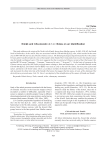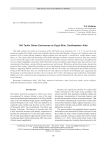The metal ages and medieval period. Рубрика в журнале - Archaeology, Ethnology & Anthropology of Eurasia

Mongol warriors of the Jochi ulus at the Karasuyr cemetery, Ulytau, Central Kazakhstan
Статья обзорная
Бесплатно
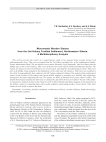
Статья научная
This article presents the results of a comprehensive study of two unusual large wooden statues with anthropomorphic faces. They were excavated from the Ust-Voikary stratified site, in the southwestern Yamalo-Nenets Autonomous Okrug. The site dwellers were native Siberians (Ugro-Samoyeds), who lived there from the Middle Ages to the recent centuries. This is one of the few sites in the region with frozen habitation deposits. The statues are unique in terms of attribution, size, preservation, and integrity of archaeological context. They were part of dwellings, being situated in the foundations of the walls near the entrance. Their faces are modeled in bas-relief. Iconographically, they conform to the Ob Ugrian sculptural tradition. The analysis of the architectural context of the location of the statues and certain details suggests a secondary use. Initially, they might have belonged to the frame supporting the roof. The statues are made of Siberian larch (Larix sibirica Ledeb.). The dendrochronological analysis has allowed us to estimate the date when the trees were felled—the late 17th century. A retrospective analysis of data on the ritual art of the northern Khanty and Mansi suggests an interpretation of the Voikary statues in comparing them with wooden sculptures representing menkvs—forest spirits. Thus, their ritual role was mostly to protect the home.
Бесплатно
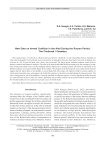
New data on armed conflicts in the Altai during the Rouran period: the Choburak I cemetery
Статья научная
This study focuses on a burial at a Rouran period cemetery, Choburak I, in the Chemalsky District, Republic of Altai, where altogether twelve burials were excavated by an expedition from the Altai State University. In kurgan 34a, a burial of a 30–35-year-old male with a horse was excavated. The burial goods included weapons, items of horse harness, utensils and domestic artifacts. The head of the buried individual had been replaced by the cranium of a ram, and certain postcranial bones revealed multiple injuries inflicted by a cutting weapon. The burial is attributed to the Dàlián tradition, associated with the Bulan-Koba culture. The analysis of the burial goods and a radiocarbon estimate suggest that the burial dates to the middle or second half of the 4th century AD. Injuries testify to armed conflicts, in which males had taken part, and support the belief that violence in the Altai was high during the Rouran period. The case is interpreted as one of decapitation. Given the parallels in adjacent regions, is can be hypothesized that the head of a ram had been used as a basis for a mask. Apparently, this peculiar custom was associated with the ritual in which the missing bodily part was replaced in specific cases of violent death.
Бесплатно

New data on iron-smelting sites in the Kuektanar and Turgun valleys, Southeastern Altai
Статья обзорная
Бесплатно
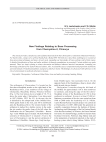
New findings relating to bone processing from Chernyatino-2, Primorye
Статья научная
The article provides a detailed account of faunal materials from the Chernyatino-2 settlement in Russian Primorye. For the first time, a large series of bone blanks from a Bohai (698–926 AD) site is described, enabling us to reconstruct bone-processing techniques and types of tools used, expanding our knowledge of bone-working craft of that region. A detailed classification of bone and antler artifacts of domestic manufacture is presented. Certain artifacts are quite unusual. There are items relating to winter movement and hitherto unknown musical instruments, extending our knowledge of medieval Far Eastern musical culture. Also, we detail the species composition and proportion of domestic and wild animals. Predominant families and genera of fish are listed. The findings are discussed with reference to the role of environment in medieval subsistence strategy.
Бесплатно

Newly discovered bronze artifacts of the Scythian period from Archekas mountain, Kuznetsk Alatau
Статья
Бесплатно

Статья научная
This study proposes a novel methodological approach to reconstructing the boundaries and structure of medieval settlements without relief features. In recent centuries, the areas of most sites were used for plowing, destroying their relief features. Erosion eventually redistributed the soil of the destroyed occupation layers. Therefore, not only the area of a site must be studied, but the adjoining areas as well. Tendencies in the distribution of the transported occupation layer mirror the thickness of the original culture-bearing deposits. Such estimates can be obtained by collating archaeological and science-based data. First, multispectral aerial photographs are subjected to statistical analysis. The results are then used to subdivide the settlement territory into smaller areas differing in vegetation density. Comparison with the results of geophysical, soil, and archaeological studies allows us to interpret those areas, to assess the state of preservation of the occupation layer (superficially disrupted, replaced, or transported). Previous multidisciplinary studies at the Kushman cluster of sites (9th–13th centuries AD) revealed substantial differences from the traditional classification (fortified settlement and group of unfortified rural settlements). Two sites can be defined as fortified settlements (Uchkakar and Kushmanskoye III), whereas Kushmanskoye II is an economic development area. The use of statistical analysis of multispectral imaging enabled us not only to confirm the previously proposed reconstruction, but also to substantiate the hypothesis about the initial boundaries and structure of the settlements.
Бесплатно
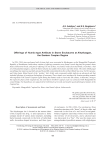
Offerings of Hunnic-type artifacts in stone enclosures at Altynkazgan, the Eastern Caspian region
Статья обзорная
Бесплатно
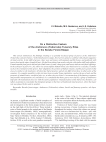
On a distinctive feature of the Andronovo (Fedorovka) funerary rites in the Baraba forest-steppe
Статья
Бесплатно
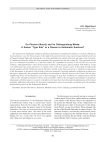
On phoinix and its distinguishing marks: a Karian “type site” or a demos to Hellenistic kamiros?
Статья научная
The oldest known inhabitants of Taşlıca (Bozburun Peninsula, in Southwestern Turkey), recorded as Phoinix in the inscriptions, were the Tloioi people. In the light of the ancient Greek corpus reported especially from the site of Fenaket (namely Rumevlek, forming the core of the dwelling zone) and the Classical wall ruins at the Acropolis, it is understood that the village has been systematically occupied since the 5th century BC. The settlement, which grew as a dominion of Kamiros as of the 3rd century BC, expanded its territory in the NE-SW axis over the centuries. Although Phoinix’s chess-board system of insulae of the megara offers parallels with Kamiros, owing to its Hellenistic-style plan and layout, it contains clues to far more ancient codes. In this study, besides being greatly equated with the Hellenistic period, Phoinix’s identity in the historical process, which gives indications of her Karianism, is discussed with the help of selective materials, basically authentic architecture tracked over the region. Apparently, the pyramidal monoliths were not unique to Phoinix; however, the Tloans, like the other neighboring komai on the mainland, seem to have managed to keep their traditions of communication with the “other world” through such features. Hence, these monoliths, which evoke the ziggurat morphology or the famous Mausoleum at Halicarnassus to connect to the afterworld, must have been the typical manifestations of the Karian mentality, sufficiently reflected by the aboriginal communities, however inevitably overshadowed by the grandest architectural projects of the Hekatomnid dynasty.
Бесплатно

On the chronological position of Siba culture metal artifacts, Northwest China
Статья научная
This study shows that bronze artifacts typical of the Siba culture (Gansu, China), such as cast convex plaques with loops, open-gap hook earrings with trumpet-shaped ends, and lamellar stemmed daggers, are similar to those from burials of the Late Krotovo (Cherno-Ozerye) and Andronovo (Fedorovo) cultures in Western Siberia, while the socketed celt-adze from the Ganguya cemetery is paralleled by those from Late Krotovo, Alakul, and Srubnaya complexes. Open rings with two opposed cast trumpet-shaped ends, open-gap hook earrings with trumpet-shaped ends, and cast convex plaques with loops, as well as stemless lamellar bronze knives with triangular section along the entire length, synchronize Siba with the cultures such as Munkh-Khairkhan, Late Qijia, Lower Xiajiadian, and Late Glazkovo. Therefore, radiocarbon dates of the Siba culture are confi rmed, suggesting that it falls within the 1800–1400 BC interval. If so, Siba bronze knives with curved spines and I-beam-shaped section of handles, as well as cast convex plaques with loops, can be considered prototypes of Late Bronze Age types of the Karasuk and Irmen cultures. Populations of western China preserved earlier (Seima-Turbino?) traditions of metallurgy, having infl uenced the culture of the mountain-steppe zone of Northern Eurasia in the last third of the 2nd millenium BC.
Бесплатно



